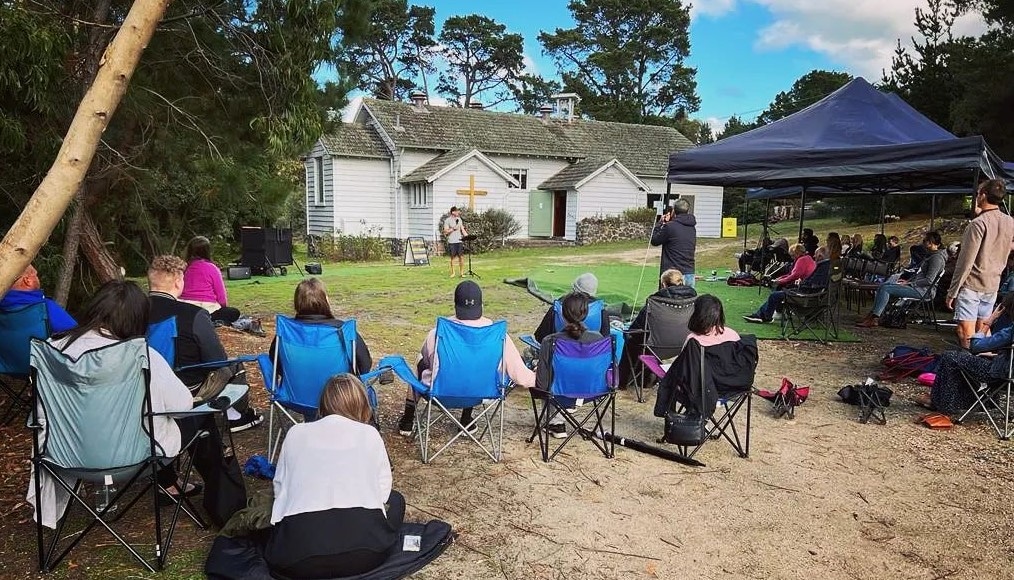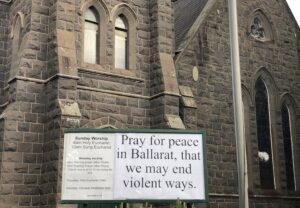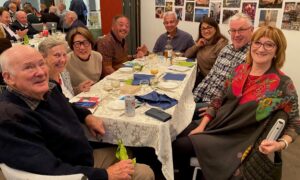
Jenan Taylor
28 June 2022
Holding services outdoors, even in winter, has proved practical for a Torquay church.
City on a Hill Surf Coast has adapted its weekly services for the outdoors, and people attend whatever the weather.
They can stay in their cars when it rains, and when conditions are fine, they bring their camp chairs or picnic blankets and set up under the trees.
Some people might bring their own firepits, and others are now also bringing their dogs to church.
Lead pastor the Reverend Louis Glazebrook said the outdoor church resonated with people who were reconnecting with the church again or going for the first time.
“We found that this very different type of meeting, literally a church without walls, is very disarming for people,” Mr Glazebrook said.
He said the church launched in 2019 but moved to Zoom with just 40 worshippers when the pandemic began.
He said the Victorian government’s COVID rules pushed them towards holding services outside.
Gatherings of up to 50 people only were allowed to take place at the time.
But when the first year’s lockdowns finished, the church found that the building it had intended to use was closed for renovations, Mr Glazebrook said.
Because the goal was to facilitate community, and it seemed that being outside provided the means to do that, the church decided to stay there.
“At the time social distancing was a really big thing, so if people were using their cars, then they were already socially distanced, so we were killing two birds with one stone,” he said.
Read more: Craigieburn church plant takes a holistic approach to community engagement
He said as summer of 2020 approached, more and more people began to attend.
“Even though people were saying it was great, I decided to ask people individually, especially our older parishioners how they felt about it, and to my surprise they really loved it.”
Despite that, they had continued scouting for potential venues, Mr Glazebrook said.
Then they conducted a cultural analysis, and found reasons to believe that in that area the church would succeed if it continued outdoors.
“People who lived on the Torquay coast loved the great outdoors, the bush, the sand and sunshine,” he said, “So we kept meeting in that way.”
Now around 65 to 70 people attend each week, Mr Glazebrook said. Most are families and singles, and a quarter are retirees and empty nesters.
Services take place on an auditorium-shaped block of land owned by the older St Wilfrid’s Anglican church.
He said as St Wilfrid’s had an aging congregation that City on a Hill was keen to help wherever they could, they paid an honorarium to use the space, cut the grass and clean the existing chapel’s bathrooms.
During the City on a Hill services there are no projector screens, and every second Sunday they distribute printed bulletins with the readings and prayers.
But they do use a radio transmitter, so that people who are in their cars during rainy weather can follow along with the radio, drive-in style.
Mr Glazebrook said the church made a feature of the peace greeting, making it an intentional ritual where individuals would spend 10 minutes meeting and getting to know someone else.
Having camp chairs and being able to move around was key to this.
He said if people were in cars because the weather was bad, they were encouraged to get rained on but move to another car and meet other people.
He said because of the large cohort of children there were also weekly children’s programs and an intergenerational service focused on what the children had done for that month.
“People who weren’t engaging in church are engaging once again because this is a very easy access, non-intimidating way of being with people,” Mr Glazebrook said.
He said it also helped dispel some of the reasons many people might use for not attending.
“The old age excuse of ‘I could never go into a church building, I’d burn up’, is just not cutting it anymore because they don’t have to go into a church building, they just have to go through a church gate,” he said, “So, it is a viable way of investigating the story of Jesus.”
But learning how to adapt and change has been a critical part of their approach.
Every Sunday morning, an hour before the service, Mr Glazebrook studies the weather radar to decide how the service will be set up.
“If it’s going to be rainy or gusty, our welcome team becomes a car park ushering team and positioning our gazebos in whatever way is most advantageous, so the wind doesn’t blow them away, and our stage is protected.”
He said he doesn’t mind getting rained on while he is preaching and tries to keep the entire atmosphere as relaxed as possible.
Mr Glazebrook said he would seek to maintain the outdoor service in some capacity for the foreseeable future.
“I don’t think it would work in Melbourne, but here it works really well. We’re happy to say we’re a young church. We can take things slow, we don’t have to have lights and don’t have to have a screen. We just have a laidback surfie bum vibe,” he said.
For more faith news, follow The Melbourne Anglican on Facebook, Twitter, or subscribe to our weekly emails.






